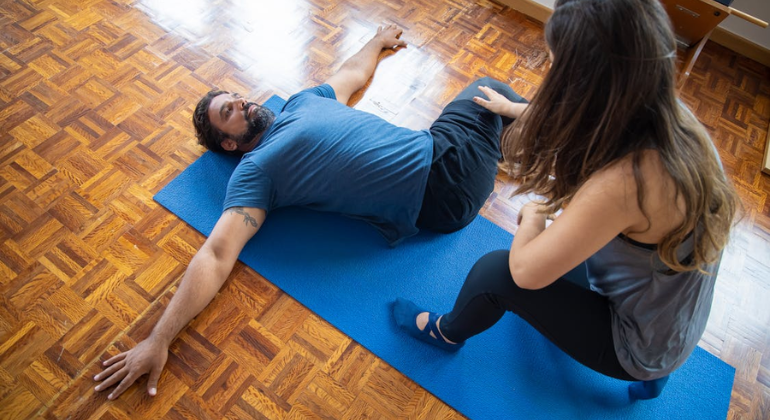Recovery is a crucial part of healing, whether you’re dealing with an injury, recovering from surgery, or managing a chronic condition. While the recovery time with home physiotherapy varies based on factors like the type of condition and commitment to therapy, home-based care ensures a personalized and effective approach to rehabilitation. In this blog, we’ll …
Recovery is a crucial part of healing, whether you’re dealing with an injury, recovering from surgery, or managing a chronic condition. While the recovery time with home physiotherapy varies based on factors like the type of condition and commitment to therapy, home-based care ensures a personalized and effective approach to rehabilitation.
In this blog, we’ll dive into physiotherapy recovery timelines at home, explore the specific recovery durations for conditions like sprains and strokes, and highlight how in-home physical therapy programs cater to individual needs for better outcomes.
How Physiotherapy Accelerates Recovery Timelines at Home
The timeline for recovery depends on several factors, including the severity of the condition and the therapy plan. Home physiotherapy offers personalized care that helps you recover faster by focusing on:
- Targeted Therapy: Sessions designed for your specific condition.
- Consistency and Comfort: Treating you in your home for better compliance.
- Progress Tracking: Adjusting the therapy plan based on your improvement.
How Long Do Common Conditions Take to Heal with Home Therapy?
- Sprains and Strains: 1–6 weeks depending on severity.
- Post-Surgical Recovery (e.g., knee replacement): 6–12 weeks.
- Neurological Conditions (e.g., stroke): Several months to a year for significant improvement.
What to Expect: Recovery Periods for Sprains with Home Physiotherapy
Sprains are among the most common injuries treated with physiotherapy. Recovery focuses on restoring movement, reducing pain, and preventing further injury.
Typical Recovery Timelines for Sprains
- Mild Sprains: Recovery is quick, taking about 1–3 weeks.
- Moderate Sprains: Healing time extends to 4–6 weeks, involving strengthening and mobility exercises.
- Severe Sprains: Requires 8–12 weeks, especially if the ligament is partially torn and intensive therapy is needed.
How Home Therapy Speeds Up Sprain Recovery
- RICE Protocol: Therapists guide you on Rest, Ice, Compression, and Elevation to manage pain and swelling.
- Stretching Exercises: Improve flexibility and prevent stiffness in the joint.
- Strengthening Workouts: Focus on stabilizing the affected area to reduce re-injury risk.
“The expected recovery period for sprains with home physiotherapy varies, but tailored exercises and professional guidance ensure faster results.”
How Long Does Home Therapy Take for Stroke Rehabilitation?
Stroke rehabilitation is a gradual process, with recovery timelines depending on the severity of the stroke and the affected areas. Home physiotherapy for stroke patients focuses on relearning basic motor skills, improving balance, and preventing complications.
Recovery Phases in Stroke Rehabilitation
- Acute Phase (0–3 Months Post-Stroke)
- Significant gains occur during this time with frequent therapy sessions aimed at restoring mobility.
- Subacute Phase (3–6 Months Post-Stroke)
- Progress slows but remains steady, focusing on advanced activities like regaining independence in daily tasks.
- Chronic Phase (6+ Months Post-Stroke)
- Improvements are more gradual, with long-term therapy aimed at preventing complications like muscle stiffness.
Key Techniques Used in Stroke Recovery
- Strengthening Exercises: Target weakened muscles to restore function.
- Gait and Balance Training: Relearn walking and standing with proper posture.
- Functional Activities: Practice everyday tasks like holding utensils or climbing stairs.
“How long does home therapy take for stroke rehabilitation? While the timeline varies, consistent sessions yield significant improvements in six months or less.”
Understanding the Duration of In-Home Physical Therapy Programs
In-home physical therapy programs are customized to suit individual needs, making the duration flexible. The recovery timeline depends on the condition being treated, the patient’s progress, and their overall health.
Short-Term Therapy Programs
These programs are designed for mild conditions or injuries and typically last 2–6 weeks.
- Example: Recovering from a sprain or mild post-surgical stiffness.
Long-Term Therapy Programs
For chronic or complex conditions like stroke or degenerative diseases, therapy may continue for several months or even years.
- Example: Stroke recovery or managing neurological disorders like Parkinson’s Disease.
Flexible Scheduling for Better Results

- Home physiotherapy offers adaptable schedules that allow patients to recover at their own pace, balancing therapy with daily routines.
What Affects Recovery Time with Home Physiotherapy?
Several factors influence the recovery timeline with home physiotherapy. By understanding these, patients can set realistic expectations and stay motivated:
1. Severity of the Condition
- Acute Injuries (e.g., mild sprains): Heal faster with consistent therapy.
- Chronic Conditions (e.g., arthritis): Require long-term management.
2. Commitment to Therapy
- Following the prescribed exercises and attending regular sessions ensures faster recovery.
3. Age and General Health
- Younger patients with better fitness levels tend to recover more quickly.
4. Personalized Treatment Plans
- Tailored plans created by experienced therapists help optimize healing times.
Why Choose Home Therapy for Faster Recovery?

Home physiotherapy offers more than just convenience; it accelerates recovery by focusing on patient-specific needs.
The Benefits of Home Physiotherapy
- One-on-One Attention: Personalized care leads to better outcomes.
- Comfort and Familiarity: Recovering in your home reduces stress and promotes healing.
- Progress Monitoring: Regular adjustments ensure therapy remains effective.
- Prevents Secondary Issues: Continuous care helps avoid complications like stiffness or muscle atrophy.
“Whether it’s a sprain or stroke recovery, home physiotherapy ensures a structured and comfortable path to healing.”
Conclusion
The recovery time with home physiotherapy varies based on the condition being treated, its severity, and the patient’s dedication to the therapy plan. While mild injuries like sprains heal within weeks, conditions like stroke or chronic pain require months of consistent effort.
By offering tailored physiotherapy recovery timelines at home, this approach ensures that patients recover safely and efficiently at their own pace. Whether you’re managing a sprain, recovering from surgery, or undergoing stroke rehabilitation, home physiotherapy provides the expertise and support needed for a successful recovery.
Take the first step toward better health by consulting a licensed physiotherapist today and starting your in-home therapy program!
Recover faster and regain mobility with personalized home physiotherapy. Whether it’s chronic pain, stroke rehabilitation, or post-surgical recovery, Painflame delivers expert care at your doorstep in Gurgaon. Schedule your consultation today!
Recent Blog : Is Home Physiotherapy Effective for Post-Surgery Recovery?
Frequently Asked Questions (FAQs)
What factors influence recovery time with home physiotherapy?
Recovery time is affected by the severity of the condition, the patient’s age, overall health, and commitment to the therapy plan. Personalized treatment and consistent sessions can enhance recovery speed.
How does home physiotherapy compare to clinic-based therapy in terms of recovery duration?
Home physiotherapy provides personalized, one-on-one care, which can lead to more efficient recovery compared to clinic-based therapy. The familiar environment may also contribute to better adherence and comfort.
Can home physiotherapy be effective for chronic conditions?
Yes, home physiotherapy can effectively manage chronic conditions by providing tailored exercises and interventions that address specific needs, helping to improve function and reduce symptoms over time.
What should I expect during a home physiotherapy session?
Sessions typically include an assessment of your condition, guided exercises, manual therapy if needed, and education on self-management techniques. The therapist will bring necessary equipment and tailor the session to your home environment.
How can I enhance the effectiveness of my home physiotherapy program?
Adhering to the prescribed exercise regimen, maintaining open communication with your therapist, and making recommended lifestyle adjustments can significantly improve the outcomes of your home physiotherapy program.






